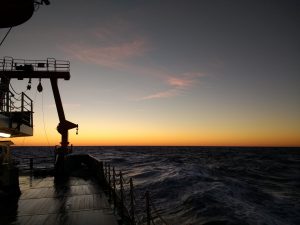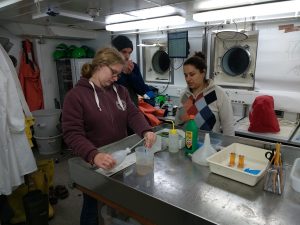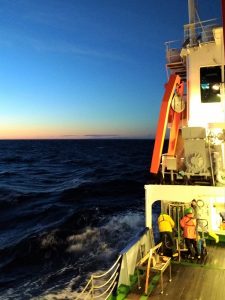The problem with such strict and frequent sampling schedules on research vessels is that night shifts are inevitable; the time and financial restraints of such a cruise mean that you cannot afford to wait around at a station until the sun is up, the weather is favourable, and more importantly, the personnel are awake!
The 24-hour sampling windows were approached with two teams working in alternating shifts; due to scheduling, all three night shifts were assigned to the same group. As the cruise progressed, so did the length and start time of the working hours. This way we were at least eased into the system; the first night was a tame 01:30-05:00, the second 03:20-06:30, and finally came the most trying of the bunch, 03:20-08:00 (and breakfast!).
In order to be as fresh and energised as possible for each early start, it became customary for the night team to retire to bed after dinner at 6pm. This allowed a reasonable amount of sleep before being rudely awakened by our alarms at either 1am or 3am depending on the sampling day. The sampling that then took place was very much the same as that which took place during daylight hours, albeit with blearier eyes and drier humour.
Attention really had to be paid to avoid any mistakes in the sampling procedures or plankton counting that filled time between stations; this however was easier said than done! The hardest part of the shift always came at the very end; the station would be ended, the
equipment brought back on board, the samples collected and the sun was finally rising. Although at this stage it felt like the work was complete, excuse the pun but this was rather a false dawn. Before you could find your way back to the comfort of your bed, all jellyfish from the 500µm bongo-net samples must be counted and measured; this was when patience and nerves were really challenged.
Although the shifts were difficult, and both our mealtimes and sleeping patterns were completely thrown out of sync; working as a group at night certainly generated a unique form of camaraderie. It also provided the perfect opportunity to watch each day’s sunrise and sunset; of which each was unique.
Post by Edwin Heavisides



